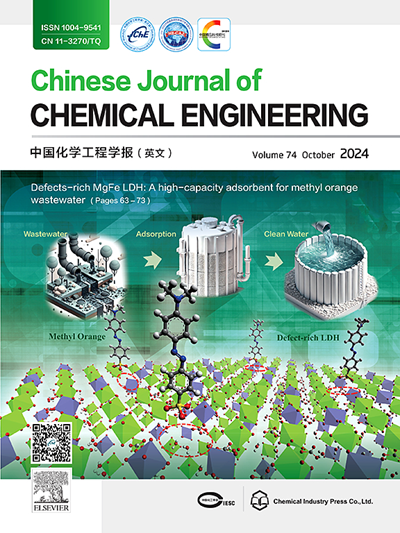Energy, exergy, economic, and environmental compromising performance of dual-stage evaporation-ammonia hybrid compression–absorption refrigeration system for the cooling supply of keto-benzene dewaxing process
IF 3.7
3区 工程技术
Q2 ENGINEERING, CHEMICAL
引用次数: 0
Abstract
Absorption refrigeration systems driven by low-temperature waste heat is one way to achieve “carbon neutrality.” Meanwhile, the keto-benzene dewaxing equipment needs a cooling capacity of 5 MW, with refrigeration temperature of −10 °C and −25 °C. This paper researches the feasibility of Dual-stage Evaporation-Ammonia Hybrid Compression–Absorption Refrigeration System (DSE-AHCARS) replacing the vapor compression refrigeration system for keto-benzene dewaxing process based on Energy, Exergy, Economic, and Environmental (4E) analysis. At the primary- and secondary-stage evaporation temperature of 0 and –23 °C, respectively, the coefficient of performance (COP) reaches the maximum value of 0.85; however, COP-electricity reaches the minimum value of 8.1. When the secondary-stage refrigeration temperature is −23 °C, CO2 emission increases from 1150 t·a−1 to 3600 t·a−1, and Life Cycle Climate Performance increases from 3.29 × 104 to 7.7 × 104 t, with the primary-stage refrigeration temperature being −15 °C–0 °C, as well as matching three parameters to ensure the 4E compromising performance by the multi-objective optimization. To guarantee that the Life Cycle Climate Performance is less than 5.5 × 104 t, the payback period is <2 a, and COP is >0.6 at the optimal operation ranges, such that the refrigeration temperature difference between primary stage and secondary stage is within 20 °C. The power of DSE-AHCARS was reduced by 77% compared with the vapor-compression refrigeration system. Therefore, the DSE-AHCARS can reduce CO2 emissions by about 6250 t·a−1 and save 1.2 × 105 t of CO2 in the Life Cycle Climate Performance term. This result shows that the DSE-AHCARS can completely replace the vapor-compression refrigeration system.
用于酮苯脱蜡工艺冷却供应的双级蒸发-氨混合压缩-吸收制冷系统的能量、能效、经济和环境影响性能
利用低温余热驱动的吸收式制冷系统是实现 "碳中和 "的途径之一。同时,酮苯脱蜡设备需要 5 兆瓦的制冷量,制冷温度为-10 °C和-25 °C。本文基于能量、能效、经济和环境(4E)分析,研究了双级蒸发-氨混合压缩-吸附制冷系统(DSE-AHCARS)替代蒸汽压缩制冷系统用于酮苯脱蜡工艺的可行性。在一级和二级蒸发温度分别为 0 和 -23 °C 时,性能系数 (COP) 达到最大值 0.85,但 COP-电能达到最小值 8.1。当二级制冷温度为-23 °C时,二氧化碳排放量从 1150 t-a-1 增加到 3600 t-a-1,生命周期气候性能从 3.29 × 104 t 增加到 7.7 × 104 t,一级制冷温度为-15 °C-0 °C,以及通过多目标优化匹配三个参数以确保 4E 妥协性能。为保证生命周期气候性能小于 5.5 × 104 t,投资回收期为 2 a,在最佳运行范围内 COP 为 0.6,使一级和二级制冷温差在 20 °C 以内。与蒸汽压缩式制冷系统相比,DSE-AHCARS 的功率降低了 77%。因此,DSE-AHCARS 可减少约 6250 t-a-1 的 CO2 排放,在生命周期气候性能方面可节约 1.2 × 105 t CO2。这一结果表明,DSE-AHCARS 可以完全取代蒸汽压缩式制冷系统。
本文章由计算机程序翻译,如有差异,请以英文原文为准。
求助全文
约1分钟内获得全文
求助全文
来源期刊

Chinese Journal of Chemical Engineering
工程技术-工程:化工
CiteScore
6.60
自引率
5.30%
发文量
4309
审稿时长
31 days
期刊介绍:
The Chinese Journal of Chemical Engineering (Monthly, started in 1982) is the official journal of the Chemical Industry and Engineering Society of China and published by the Chemical Industry Press Co. Ltd. The aim of the journal is to develop the international exchange of scientific and technical information in the field of chemical engineering. It publishes original research papers that cover the major advancements and achievements in chemical engineering in China as well as some articles from overseas contributors.
The topics of journal include chemical engineering, chemical technology, biochemical engineering, energy and environmental engineering and other relevant fields. Papers are published on the basis of their relevance to theoretical research, practical application or potential uses in the industry as Research Papers, Communications, Reviews and Perspectives. Prominent domestic and overseas chemical experts and scholars have been invited to form an International Advisory Board and the Editorial Committee. It enjoys recognition among Chinese academia and industry as a reliable source of information of what is going on in chemical engineering research, both domestic and abroad.
 求助内容:
求助内容: 应助结果提醒方式:
应助结果提醒方式:


